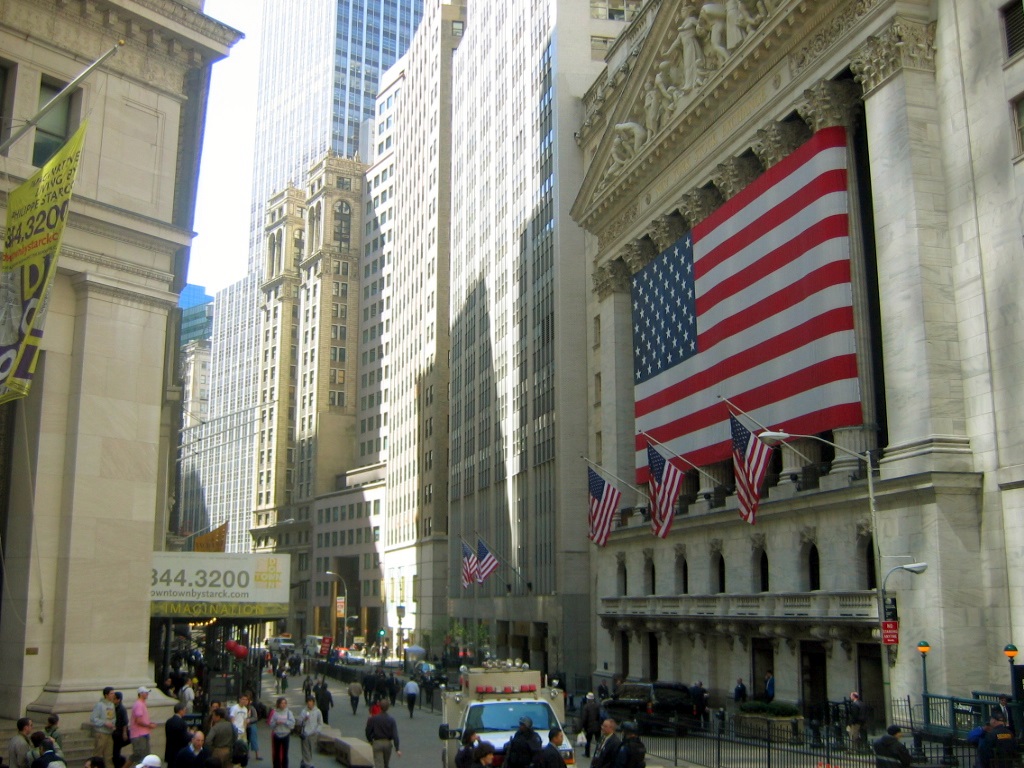
Wall Street
Wall Street is a street in the Financial District of Lower Manhattan in New York City. Eight city blocks long, it runs between Broadway in the west and South Street and the East River in the east. The term "Wall Street" has become a metonym for the financial markets of the United States as a whole, the American financial services industry, New York–based financial interests, or the Financial District itself. Anchored by Wall Street, New York has been described as the world's principal fintech and financial center.[1][2]
This article is about the street in Lower Manhattan. For the neighborhood commonly referred to as Wall Street, see Financial District, Manhattan. For the U.S. economy at large, for which "Wall Street" is commonly used as a metonym, see Economy of the United States. For other uses, see Wall Street (disambiguation).Native name
The street was originally known in Dutch as Het Cingel ("the Belt") when it was part of New Amsterdam during the 17th century. An actual wall existed on the street from 1653 to 1699, and during the 18th century, the location served as a slave market and securities trading site, and from 1703 onwards the location of New York's first city hall, Federal Hall. In the early 19th century, both residences and businesses occupied the area, but increasingly the latter predominated, and New York's financial industry became centered on Wall Street. During the 20th century, several early skyscrapers were built on Wall Street, including 40 Wall Street, once the world's tallest building.
The Wall Street area is home to the New York Stock Exchange, the world's largest stock exchange by total market capitalization, as well as the Federal Reserve Bank of New York, and several commercial banks and insurance companies. Several other stock and commodity exchanges have also been located in Lower Manhattan near Wall Street, including the New York Mercantile Exchange and other commodity futures exchanges, along with the NYSE American. To support the business they did on the exchanges, many brokerage firms owned offices nearby. The direct economic impacts of Wall Street activities extend worldwide.
Wall Street itself is a narrow and winding street running from the East River to Broadway and lined with skyscrapers, as well as the New York Stock Exchange Building, the Federal Hall and 1 Wall Street at its western end. The street is near multiple New York City Subway stations, ferry terminals, and the World Trade Center site.
Wall Street's architecture is generally rooted in the Gilded Age.[22] The older skyscrapers often were built with elaborate facades, which have not been common in corporate architecture for decades. There are numerous landmarks on Wall Street, some of which were erected as the headquarters of banks. These include:
Another key anchor for the area is the New York Stock Exchange Building at the corner of Broad Street. It houses the New York Stock Exchange, which is by far the world's largest stock exchange per market capitalization of its listed companies,[66][67][68][69] at US$28.5 trillion as of June 30, 2018.[70] City authorities realize its importance, and believed that it has "outgrown its neoclassical temple at the corner of Wall and Broad streets", and in 1998, offered substantial tax incentives to try to keep it in the Financial District.[18] Plans to rebuild it were delayed by the September 11 attacks.[18] The exchange still occupies the same site. The exchange is the locus for a large amount of technology and data. For example, to accommodate the three thousand people who work directly on the exchange floor requires 3,500 kilowatts of electricity, along with 8,000 phone circuits on the trading floor alone, and 200 miles (320 km) of fiber-optic cable below ground.[42]
With Wall Street being historically a commuter destination, a plethora of transportation infrastructure has been developed to serve it. Pier 11 near Wall Street's eastern end is a busy terminal for New York Waterway, NYC Ferry, New York Water Taxi, and SeaStreak. The Downtown Manhattan Heliport also serves Wall Street.
There are three New York City Subway stations under Wall Street:
From 1934 to the mid-1980s, Wall Street Skyport served as a seaplane base that was primarily used by suburban commuters.